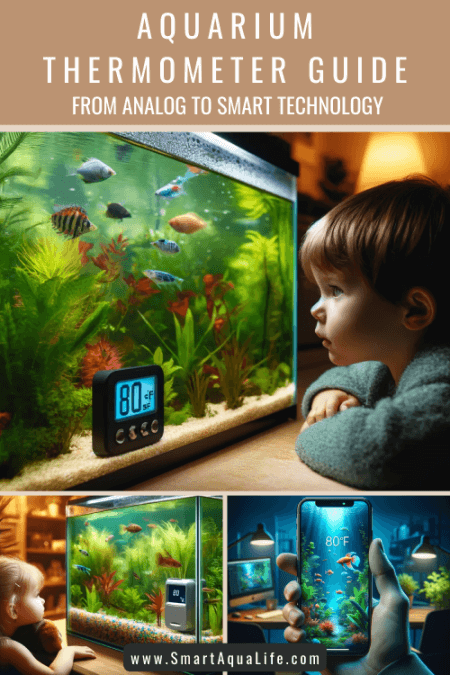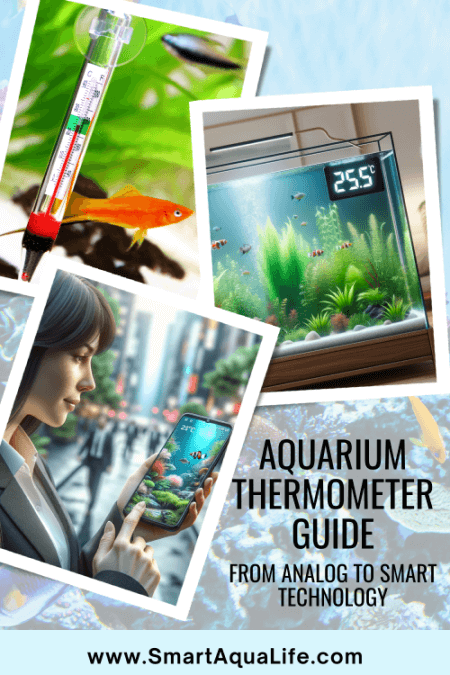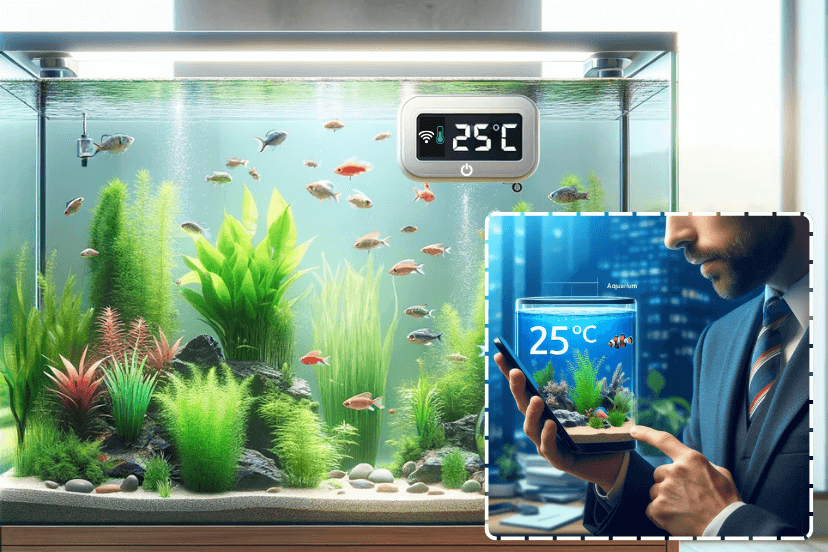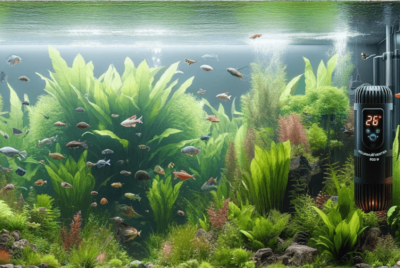Aquarium Thermometer Guide: From Analog to Smart Technology
Hey fellow aquarists and fishkeeping enthusiasts! The moment you step into the fascinating world of aquatics, you realize how vital it is to keep every aspect of your aquarium in check for the thriving life beneath the water. One key player in this balancing act is the reliable aquarium thermometer. This indispensable gadget ensures that the water temperature stays just right, providing a comfortable habitat for your fish and plants. Whether you’re a beginner or a seasoned pro, understanding the nuances of different aquarium thermometers can make a world of difference in your aquatic care routine. From analog dials that have graced aquariums for decades to the latest smart thermometers that send alerts directly to your phone, the evolution of these devices is as dynamic as the ecosystems they monitor.
In this ever-changing aquatic landscape, the choice of an aquarium thermometer is more than just a matter of preference; it’s about accuracy, convenience, and the well-being of your aquatic family. The right thermometer not only helps in preventing temperature-related stress and diseases but also acts as your eyes when you’re not around to check the water conditions. As we explore the types and benefits of various thermometers, from the simplicity of analog models to the advanced features of smart thermometers, you’ll find that this small tool is a giant leap towards a healthy and thriving aquarium. So, let’s embark on this temperature-tuning journey together, ensuring our underwater worlds are as close to perfect as they can be.
The Importance of Monitoring Aquarium Temperature
Maintaining the perfect water temperature is essential for your fish’s health, and using an aquarium thermometer is the best way to achieve this. Whether it’s a straightforward analog or an advanced smart aquarium thermometer, knowing the ideal temperature is crucial. For tropical fish, a warm habitat between 24°C and 27°C (75°F and 80°F) is ideal, whereas cooler water species flourish at 20°C to 23°C (68°F to 74°F). Consistently checking the water temperature with a reliable aquarium thermometer ensures your aquatic pets live in a comfortable and safe environment. It’s important to understand that a stable temperature, monitored by an accurate aquarium thermometer, is vital for the well-being and longevity of your aquarium’s inhabitants. Incorporating regular temperature checks into your routine with an aquarium thermometer can prevent potential problems, highlighting its importance not just as a tool, but as an essential part of aquarium care.
What is the Ideal Aquarium Temperature?
Maintaining the perfect water temperature is essential for your fish’s health, and using an aquarium thermometer is the best way to achieve this. Whether it’s a straightforward analog or an advanced smart aquarium thermometer, knowing the ideal temperature is crucial. For tropical fish, a warm habitat between 24°C and 27°C (75°F and 80°F) is ideal, whereas cooler water species flourish at 20°C to 23°C (68°F to 74°F). Consistently checking the water temperature with a reliable aquarium thermometer ensures your aquatic pets live in a comfortable and safe environment. It’s important to understand that a stable temperature, monitored by an accurate aquarium thermometer, is vital for the well-being and longevity of your aquarium’s inhabitants. Incorporating regular temperature checks into your routine with an aquarium thermometer can prevent potential problems, highlighting its importance not just as a tool, but as an essential part of aquarium care.
Evolution of Aquarium Thermometers
The journey of the aquarium thermometer from simple, manual devices to sophisticated, smart technology mirrors the evolution of aquarium care itself. Initially, aquarists relied on basic analog thermometers, which required manual checking. However, as technology advanced, digital and eventually smart thermometers emerged, offering greater accuracy and convenience. This progression underscores a growing emphasis on precision and ease in aquarium maintenance.
Understanding Aquarium Thermometers

What is an Aquarium Thermometer?
An aquarium thermometer is an indispensable tool for any aquarist, designed to accurately measure the water temperature of an aquarium. This simple device helps in maintaining the ideal conditions required for aquatic life to flourish. By providing precise temperature readings, aquarium thermometers play a crucial role in the day-to-day management of aquariums, ensuring the habitat is safe and comfortable for all inhabitants.
Why is Temperature Monitoring Crucial?
Temperature monitoring in an aquarium is crucial because it directly impacts the health and metabolism of the fish and plants within. Each species has specific temperature requirements; deviating from these can lead to stress, disease, and even death. An accurate aquarium thermometer helps maintain the delicate balance of your aquatic ecosystem, ensuring your aquatic pets thrive.
Types of Aquarium Thermometers
Analog Thermometers

Analog thermometers are the traditional choice for many aquarists. They are simple, reliable, and easy to read.
Glass Thermometers
Glass thermometers, often seen hanging inside the tank, offer a classic method for measuring water temperature. Their straightforward design and direct contact with water make them a dependable option for aquarists valuing simplicity.
Standing and Floating Types
Standing and floating thermometers provide versatility in placement and are easily adjusted within the aquarium. These types are popular for their durability and ease of use, catering to a wide range of aquarium setups.
Digital Thermometers

Digital thermometers have become increasingly popular for their precision and ease of reading.
Stick-on Thermometers
Stick-on thermometers, attached to the outside of the aquarium glass, offer a convenient way to monitor temperatures at a glance. Their ease of installation and maintenance-free design make them a favorite among busy aquarists.
Submersible Digital Models
Submersible digital models provide highly accurate readings by being placed directly in the water. They often feature large, easy-to-read displays and can be an excellent choice for those seeking detailed temperature monitoring.
Smart Aquarium Thermometers

Smart aquarium thermometers represent the cutting edge in aquarium temperature monitoring, offering unparalleled convenience and accuracy.
Features and Connectivity
These advanced devices come packed with features like remote monitoring, alerts, and data logging, connecting to your smartphone or home network for real-time updates on your aquarium’s conditions.
Integrating with Other Smart Devices
Smart aquarium thermometers can often integrate with other smart aquarium devices, creating a fully automated system that manages lighting, filtration, and heating based on real-time data, simplifying aquarium care like never before.
Pros and Cons of Each Type
Analyzing Analog Thermometers
Analog thermometers, a staple in many aquariums, offer simplicity and reliability. They require no batteries and are generally more affordable. However, they can be less precise than digital options and harder to read, especially from a distance. For aquarists who prefer a straightforward approach and may not need pinpoint accuracy, an analog aquarium thermometer can be an excellent choice.
Digital Thermometer Advantages
Digital thermometers bring precision to aquarium temperature monitoring, featuring easy-to-read displays that offer exact measurements at a glance. They are versatile, with some models capable of alerting you to sudden temperature changes. The downside? They rely on batteries or external power sources, which could fail, and typically cost more than their analog counterparts.
The Smart Thermometer Revolution
The smart aquarium thermometer is transforming how we interact with our aquatic environments. These devices offer the ultimate in convenience, with remote monitoring, alerts, and integration with other smart devices. However, they come with a higher price tag and require a stable internet connection, which could be a drawback for some users.
Setting Up Your Aquarium Thermometer
Installation Tips
When setting up your aquarium thermometer, ensure it’s secure and positioned away from heat sources like lights or heater vents. For digital and smart models, follow the manufacturer’s instructions closely to ensure accurate connectivity and function. Proper setup is key to getting reliable readings that can help maintain your aquarium’s health.
Placement for Accuracy
Placement is critical for accurate temperature readings. Ideally, position your aquarium thermometer away from the heater and near the middle of the tank to get a representative reading of your aquarium’s overall temperature. Avoid placing it too close to the tank edges or surface, where temperatures might not reflect the true water conditions.
Smart Technology in Aquaristics
Enhancing Aquarium Care with Smart Devices
Smart technology, including smart aquarium thermometers, is revolutionizing aquarium care. These devices not only monitor temperature but can also integrate with filters, lights, and feeders to automate and optimize the aquarium environment. This integration enhances the well-being of aquatic life, making advanced fishkeeping more accessible to enthusiasts at all levels.
Future Trends in Aquarium Monitoring
The future of aquarium monitoring is bright, with advancements in smart technology leading the way. Expect to see more intuitive devices that can predict and adjust to changes in the aquarium environment, offering even more sophisticated ways to care for aquatic life. The focus will be on creating ecosystems that are as self-sustaining as possible, reducing the workload on the aquarist and increasing enjoyment of the hobby.
Choosing the Right Thermometer for Your Aquarium

Factors to Consider
When selecting an aquarium thermometer, accuracy is paramount. Additionally, consider the thermometer’s ease of use, durability, and compatibility with your aquarium setup. The right aquarium thermometer should suit your specific needs, whether you’re managing a delicate reef tank or a freshwater community aquarium. Cost may also be a factor, but remember, investing in a reliable thermometer can save you from potential losses and stress in the long run.
Recommendations for Different Aquarium Types
For small freshwater tanks, a simple digital thermometer might suffice, providing quick and accurate readings. Reef aquariums, with their sensitive inhabitants, benefit from the precision of smart thermometers, which offer alerts for sudden changes. Larger, more complex setups might require multiple thermometers for accurate monitoring across different tank zones.
Maintenance and Troubleshooting
Regular Maintenance Tips
Maintaining your aquarium thermometer is crucial for its longevity and accuracy. Regularly check the battery (if applicable) and ensure the device is clean and free from algae or mineral deposits. For analog thermometers, a gentle wipe with a soft cloth can keep them readable, while digital and smart thermometers might require recalibration according to the manufacturer’s guidelines.
Troubleshooting Common Issues
If your aquarium thermometer starts showing erratic readings, first check for battery issues or signs of damage. Recalibration is often necessary for digital models, while analog ones might simply need repositioning away from heat sources or cold drafts. For smart thermometers, connectivity problems can often be resolved by checking Wi-Fi settings or updating the device’s firmware.
Real-life Application and Tips
From Hobbyists to Professionals
Both hobbyists and professional aquarists rely on accurate aquarium thermometers to ensure the health of their aquatic ecosystems. From breeding rare species to maintaining large public aquariums, the principles of temperature monitoring remain the same, underscoring the thermometer’s universal importance across all levels of fishkeeping.
Personal Experience and Advice
In my journey, I’ve found that a combination of digital and smart thermometers offers the best of both worlds—immediate readings and remote monitoring. Don’t hesitate to invest in a quality aquarium thermometer; it’s a small price for the peace of mind and safety it brings to your underwater charges.
Conclusion
In wrapping up our deep dive into the critical role of the aquarium thermometer in both hobbyist and professional settings, it’s clear that this small device is more than just a gadget; it’s a guardian of your aquatic ecosystem. Selecting, using, and maintaining the right aquarium thermometer ensures that your fish, plants, and other aquatic inhabitants enjoy a life that’s as close to their natural habitat as possible. This care and attention to detail highlight the dedication and love we have for our underwater worlds. It’s not just about keeping water at a certain temperature; it’s about understanding and replicating the delicate balances of nature in our own homes.
Moreover, as technology advances, the aquarium thermometer continues to evolve, offering features that were once considered futuristic. From alerts sent directly to your smartphone to seamless integration with other smart aquarium devices, these innovations make fishkeeping more accessible and enjoyable than ever before. So, as you continue on your fishkeeping journey, remember that the success of your aquatic environment begins with the basics, like the precise monitoring provided by a reliable aquarium thermometer. Embrace the advancements, but never underestimate the importance of this fundamental tool in creating a thriving underwater oasis for your beloved aquatic companions.

FAQs
FAQ 1: How often should I check my aquarium’s temperature?
Regularly monitoring your aquarium’s temperature is key to a healthy environment. It’s recommended to check the temperature at least once a day using a reliable aquarium thermometer. This daily check helps you catch and correct any fluctuations early, ensuring the well-being of your aquatic friends.
FAQ 2: What is the best type of aquarium thermometer for beginners?
For beginners, digital thermometers are an excellent choice. They are easy to read, affordable, and provide accurate temperature readings. A good quality digital aquarium thermometer can serve as a dependable tool, helping novice aquarists maintain optimal conditions in their tanks.
FAQ 3: Can I use multiple thermometers in one tank?
Yes, using multiple aquarium thermometers in one tank can be beneficial, especially in larger setups. It allows for cross-verification of temperature readings, ensuring accuracy and helping to identify any temperature gradients within the tank. This approach adds an extra layer of safety for your aquatic environment.
FAQ 4: What should I do if my thermometer gives inconsistent readings?
If your aquarium thermometer provides inconsistent readings, first check for any signs of damage or battery life issues. Calibration might be necessary for digital models. If problems persist, consider replacing the thermometer to ensure continuous accurate monitoring of your aquarium’s temperature.
FAQ 5: How can I ensure my smart thermometer stays connected for alerts?
To ensure your smart aquarium thermometer stays connected for alerts, regularly check your Wi-Fi network’s stability and the device’s connectivity status. Keep the thermometer’s firmware updated and follow the manufacturer’s guidelines for troubleshooting any connection issues. This proactive approach keeps you informed about your tank’s conditions at all times.




